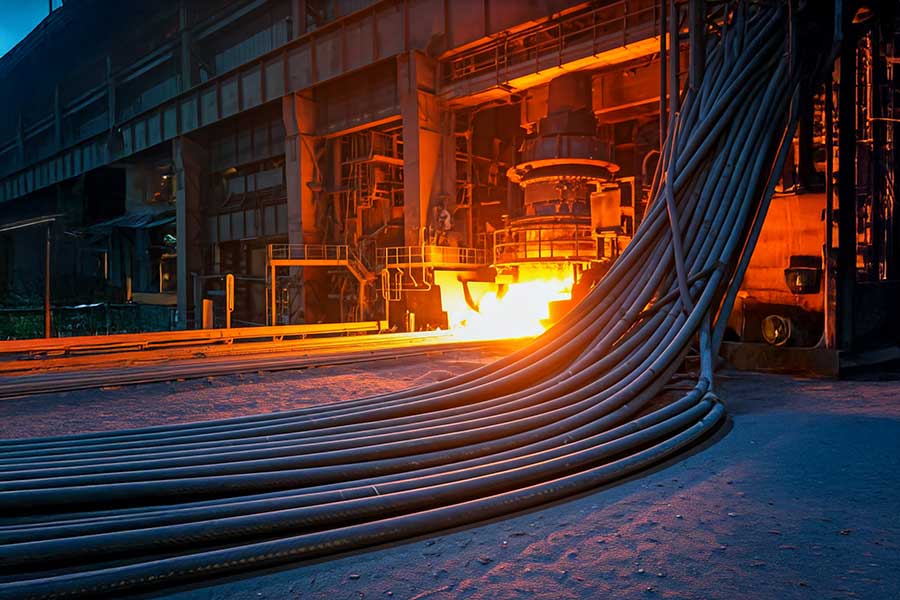
Some industrial applications require cables to be exposed to extreme temperatures. Cables used in areas such as melting furnaces, furnaces, engine compartments, foundries, iron and steel factories, glass production facilities, petrochemical plants and aviation must be resistant to high temperatures and maintain their performance. Cables specially designed for such applications are called "high temperature cables". Ülkü Kablo is one of the few production facilities that can produce cables equipped with materials resistant to high temperatures. In this text, we will take a closer look at what high-temperature cables are, their types, characteristics, materials used, and what to consider when choosing them.
The Importance of High Temperature Cables
Standard PVC insulated cables can operate at temperatures such as 70°C to 90°C, generally. However, when exposed to higher temperatures, insulating materials may melt, crack or lose their properties. This can lead to short circuits, electrical faults, and even fires. High-temperature cables, on the other hand, can withstand much higher temperatures and continue to work reliably because they are made of special materials.
Types of High Temperature Cables
High-temperature cables can be classified into different types according to their insulating material:
- Silicone Cables: Silicone rubber insulated cables can withstand temperatures from -60°C to +200°C (up to +250°C for short periods). They offer high flexibility, good electrical properties and chemical resistance.
- PTFE (Teflon) Cables: PTFE (Polytetrafluoroethylene) insulated cables can withstand temperatures from -200°C to +260°C. They have excellent chemical resistance, low coefficient of friction and good electrical properties.
- Mica Cables: Mica insulated cables can withstand very high temperatures (+500°C and above). They have fire resistance, radiation resistance and good electrical properties. They are often used in fire alarm systems and high temperature sensors.
- Glass Fiber Cables: Glass fiber braided or coated cables can withstand high temperatures (up to +400°C). They offer mechanical durability and flame retardancy.
- Ceramic Cables: Ceramic insulated cables can withstand the highest temperatures (+1000°C and above). They are ideal for extreme temperature applications and fire safety systems.
Features of High Temperature Cables
Here are some important features to consider when choosing high temperature cables:
- Temperature Resistance: The maximum temperature values that the cable can withstand continuously and for a short time are important.
- Environmental Conditions: Other environmental factors (humidity, chemicals, UV rays, etc.) to which the cable will be exposed should be considered.
- Flexibility: The cable needs to be flexible enough for easy laying.
- Mechanical Strength: The cable must be resistant to abrasion, impacts and vibrations.
- Electrical Properties: The conductivity, insulation resistance and dielectric strength of the cable are important.
- Flame Retardancy: In terms of fire safety, cables with flame retardant properties should be preferred.
- Standards: Cables must comply with the relevant standards (VDE, IEC, UL, etc.).
Materials Used in High Temperature Cables
The main materials used in high temperature cables are:
- Conductors: Nickel-plated copper, silver-plated copper, nickel or nickel alloys.
- Insulation Materials: Silicone rubber, PTFE (Teflon), mica, glass fiber, ceramic.
- Sheath Materials: Silicone rubber, glass fiber mesh, metal mesh, special thermoplastic elastomers.
Things to Consider When Choosing a High Temperature Cable
Choosing the right high-temperature cable is critical to the success and safety of the application. Here are some factors to look out for:
- Operating Temperature: The maximum temperature values to which the cable will be exposed continuously and for a short time must be determined correctly.
- Environmental Conditions: Other environmental factors (humidity, chemicals, UV rays, etc.) to which the cable will be exposed should be considered.
- Application Area: The requirements of the area where the cable will be used (flexibility, mechanical strength, flame retardancy, etc.) should be taken into account.
- Standards and Regulations: Standards and regulations to be applied (e.g., fire safety) should be considered.
Uses of High Temperature Cables
High temperature cables are used in a wide variety of industrial applications:
- Heat Treatment Furnaces and Melting Furnaces: Sensor cables and power cables resistant to high temperatures.
- Engine Compartments and Exhaust Systems: In the automotive, aerospace and marine industries.
- Lighting Fixtures & High Temperature Lamps: Theater lighting, industrial lighting.
- Petrochemical Plants and Refineries: Applications requiring high temperature and chemical resistance.
- Glass and Ceramic Production Facilities: Control and power cables resistant to high temperatures.
- Fire Alarm and Detection Systems: Cables that must maintain their function in case of fire.
Conclusion
High-temperature cables are specifically designed to provide a reliable and uninterrupted transmission of electricity in extreme conditions. Choosing the right cable is critical to the safety and success of the application. Choosing the appropriate cable, taking into account the requirements of the application and environmental conditions, is a fundamental step for a long-lasting and trouble-free operation.
